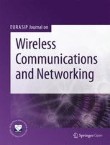EURASIP Journal on Wireless Communications and Networking welcomes submissions to the thematic series on 'Ultra-Reliable-and-Available Low-Latency Communications for 5G/B5G-enabled IoT'.
The Internet of Things (IoT) provides continuous connectivity for various physical objects (e.g., sensors, mobile phones, vehicles, RFID tags, other electronic embedded devices, etc.) as well as humans by allowing them to communicate and exchange data. IoT encompass a massive number of low-cost and low-power devices that must transmit a diverse set of messages observed from their environment in a reliable and available way to deliver a plethora of smart applications. Moreover, one of the critical missions of IoT is envisioned to enable real-time control and automation of dynamic processes in various fields (e.g., industrial process automation and manufacturing, energy distribution, intelligent transport systems, etc.). This mission requires communications with very high reliability and availability, as well as very low end-to-end latency at the millisecond level.
5G/B5G is considered as a key enabler in meeting continuously increasing demands for future IoT services with the near real-time, high reliable and available transmission requirements. These requirements of IoT in diverse smart applications are combined with 5G/B5G, which has brought multifaceted technical challenges for leveraging the features of 5G/B5G and technologies, such as massive multiple-input multiple-output (MIMO) systems, non-orthogonal waveforms, non-orthogonal multiple access, device-to-device (D2D) communications, millimeter wave communications, small cells, edge/fog computing and cross-layer design, to cater for IoT requirements.
This special issue intends to bring together the leading researchers and developers from both academia and industry to present their latest research and innovation on ultra-reliable-and-available, low-latency (URALL) communications for 5G/B5G-enabled IoT. All submissions should neither have been published previously nor be currently under consideration for publication elsewhere. The submitted papers will undergo a strict peer review process based on originality, quality, and relevance to this special issue and the journal.
Potential topics include but are not limited to the following:
- Interference mitigation and management techniques for URALL 5G/B5G-enabled IoT
- QoS (Quality of Service) / QoE (Quality of Experience) in 5G/B5G-enabled IoT
- Waveforms, coding, MIMO techniques and multiple access techniques for URALL IoT
- Resource allocation and management schemes for URALL 5G/B5G-enabled IoT
- Mobile edge computing with focus on URALL communications
- Energy efficiency in URALL 5G/B5G-enabled IoT
- Performance analysis for URALL communications in 5G/B5G-enabled IoT
- D2D communications for supporting URALL IoT
- Cooperative schemes for URALL 5G/B5G-enabled IoT
- Cross-layer design techniques in URALL 5G/B5G-enabled IoT
- Data reliability, privacy and security with URALL requirements for 5G/B5G-enabled IoT
- Network infrastructure, backhaul & core network issues for URALL 5G/B5G-enabled IoT
- Vehicle to vehicle (V2V) communications for URALL 5G-enabled IoT
- Energy harvesting, storage, and recycling for URALL 5G/B5G-enabled IoT
- Other emerging techniques for URALL 5G/B5G-enabled IoT
Submission Instructions
Before submitting your manuscript, please ensure you have carefully read the submission guidelines for EURASIP Journal on Wireless Communications and Networking. The complete manuscript should be submitted through the EURASIP Journal on Wireless Communications and Networking submission system. To ensure that you submit to the correct thematic series please select the appropriate special issue in the drop-down menu upon submission. All submissions will undergo rigorous peer review and accepted articles will be published within the journal as a collection.
Deadline for submissions: 30 April 2019
Lead Guest Editor
Chunguo Li, Southeast University, China
Guest Editors
Yunfei Chen, University of Warwick, UK
Zheng Chang, University of Jyvaskyla, Finland
Nan Zhao, Dalian University of Technology, China
Junhui Zhao, East China Jiaotong University, China
Submissions will also benefit from the usual advantages of open access publication:
Rapid publication: Online submission, electronic peer review and production make the process of publishing your article simple and efficient
High visibility and international readership in your field: Open access publication ensures high visibility and maximum exposure for your work - anyone with online access can read your article
No space constraints: Publishing online means unlimited space for figures, extensive data and video footage
Authors retain copyright, licensing the article under a Creative Commons license: articles can be freely redistributed and reused as long as the article is correctly attributed
